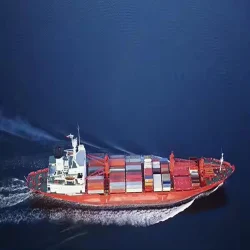Ocean Freight Container Shipping
2024-05-25
Ocean freight container shipping is a critical component of global trade, enabling the transportation of large quantities of goods across the world via cargo ships. Here’s an overview of the key aspects of ocean freight container shipping:
Types of Containers
1. Standard Dry Containers: Available in 20-foot and 40-foot sizes, used for general cargo.
2. High Cube Containers: Similar to standard containers but taller, allowing for more volume.
3. Refrigerated Containers (Reefers): Equipped with cooling systems for perishable goods.
4. Open Top Containers: Used for oversized cargo that cannot fit through standard container doors.
5. Flat Rack Containers: For heavy or awkwardly shaped cargo, such as machinery or vehicles.
6. Tank Containers: Designed for liquid cargo like chemicals or food-grade liquids.
Shipping Process
1. Booking: Arranging space on a vessel with a shipping line.
2. Loading: Cargo is packed into containers and transported to the port.
3. Customs Clearance: Documentation is reviewed and approved by customs authorities.
4. Transport: Containers are loaded onto ships and transported to the destination port.
5. Unloading: Containers are offloaded at the destination port.
6. Final Delivery: Containers are transported from the port to the final destination.
Key Players
1. Shipping Lines: Companies that operate the ships (e.g., Maersk, MSC, COSCO).
2. Freight Forwarders: Facilitate the shipping process and manage logistics.
3. Port Authorities: Manage port operations and infrastructure.
4. Customs Authorities: Ensure compliance with import/export regulations.
Shipping Routes
- Main Trade Lanes: Major routes such as Asia-Europe, Trans-Pacific (Asia to North America), and Trans-Atlantic (Europe to North America).
- Feeder Services: Smaller routes connecting regional ports to major transshipment hubs.
Costs
- Freight Rates: Determined by factors such as container type, route, fuel prices, and market demand.
- Additional Charges: Can include port handling fees, customs duties, and insurance.
Documentation
- Bill of Lading (B/L): A legal document between the shipper and carrier detailing the type, quantity, and destination of the goods.
- Commercial Invoice: Provided by the seller to the buyer, detailing the transaction.
- Packing List: Describes the contents of the shipment.
- Certificates of Origin: Verifies the origin of the goods.
Advantages
- Cost-Effective: Economical for transporting large volumes over long distances.
- Versatility: Can handle a wide range of cargo types.
- Global Reach: Access to virtually any international market.
Challenges
- Transit Times: Longer compared to air freight.
- Customs Delays: Potential hold-ups at borders.
- Weather Dependency: Adverse weather can impact schedules.
Innovations
- Digitalization: Use of electronic documentation and tracking systems.
- Sustainability: Efforts to reduce carbon emissions through cleaner fuels and more efficient ships.
- Automation: Automated ports and cargo handling to increase efficiency.
Ocean freight container shipping remains a backbone of international trade, providing a reliable and efficient method for moving goods globally.



